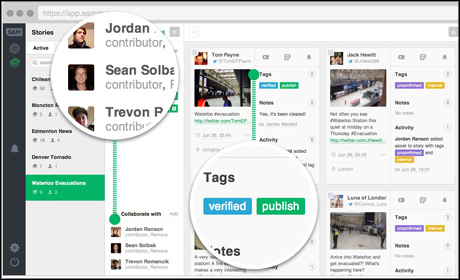SAM, which launched last week after four months in private beta, provides a central hub for different departments and teammembers within a newsroom to collaborate on finding, verifying and archiving newsworthy content from social media.
Designed to speed up the process of including accurate and reliable UGC in stories, the key philosophy behind the platform is "simplifying workflow," SAM's founder James Neufeld told Journalism.co.uk.
"It's a tool that helps legal and graphics and publishing and editors, all sitting on the tool at the same time," he explained.
Users create a 'wire' to search for hashtags, locations, media types or individual users across Twitter, Facebook and Instagram.
Wires are updated in real-time, and search filters can be modified on the fly as a story develops.
Users can then create a colloborative workspace by adding a 'story', into which others users can be invited and UGC can be added from wires via drag-and-drop.
In this shared space, UGC is displayed alongside a simple status bar allowing multiple users to use tags and notes to see at a glance whether it has been verified, for example, and whether permission to use it has been granted by the copyright owner.

SAM users can add tags to UGC to show whether it has been verified and approved for publication by the owner
For larger newsrooms, or those spread across different geographical areas, Neufeld said he had observed a lot of "back-and-forth" in communications between different departments.
The result of this is that the process of UGC verification – although necessary – a slower process than most journalists would prefer, he added.
"I think actually the bottleneck was email," said Neufeld.
"SAM wants to create that central streamlined tool that says 'here is a real-time piece of content' – it's always changing, but it's always stored in SAM.
"You don't need to go back and look for it. It's always there and anything you need to do, you can connect to that asset in SAM.
Stories can be made public to show a curated timeline of an event or breaking news story.
As a tool for storytelling, Neufeld believes that what sets SAM apart from platforms such as Storify and similar curation tools is that it is entirely back-end.
This allows news outlets to display their own branding, with a range of templates available for different types of story.
"We're taking an API approach," Neufeld explained. "There's nothing in SAM today that allows you to embed a story and give you that linear blog post."
This is something Neufeld believes will allow newsrooms to tell stores "in their own way", with the "limitations" of a linear or grid view.
Since SAM was released from beta on Monday (June 30), the team of five behind the platform plan to add one new service a week while being careful to avoid what Neufeld calls "feature bloat".
"When it comes to the bigger features, we want to support all social networks," he explained.
"Today it's Twitter, Instagram and Facebook. That means we have a lot of room to move quickly on better Youtube support.
"We can move onto things like Reddit, Flickr and Vimeo."
Neufeld said that "some of the world's leading newsrooms" from London, New York and Singapore were already using SAM.
The platform is available in three price packages from $375 [£219] per month for smaller publishers (teams of five with 25 wires available) up to $1,125 for 15 users with 75 wires.
Neufeld likens SAM's pricing structure to Wordpress VIP, which is says is in-line with the service the platform aims to offer "as a top-end tool".
Free daily newsletter
If you like our news and feature articles, you can sign up to receive our free daily (Mon-Fri) email newsletter (mobile friendly).
Related articles
- Blockchain can help news publishers fight risks posed by fake news websites
- Six self-care tips for journalists to stay sane during the general election
- RISJ Digital News Report 2024: Three essential points for your newsroom
- Seven tips for using LinkedIn as a freelance journalist
- Journalists are happy to be disconnecting from platforms, should news organisations be worried?









